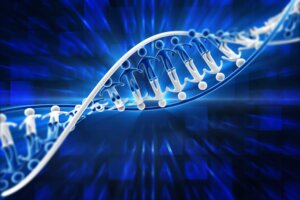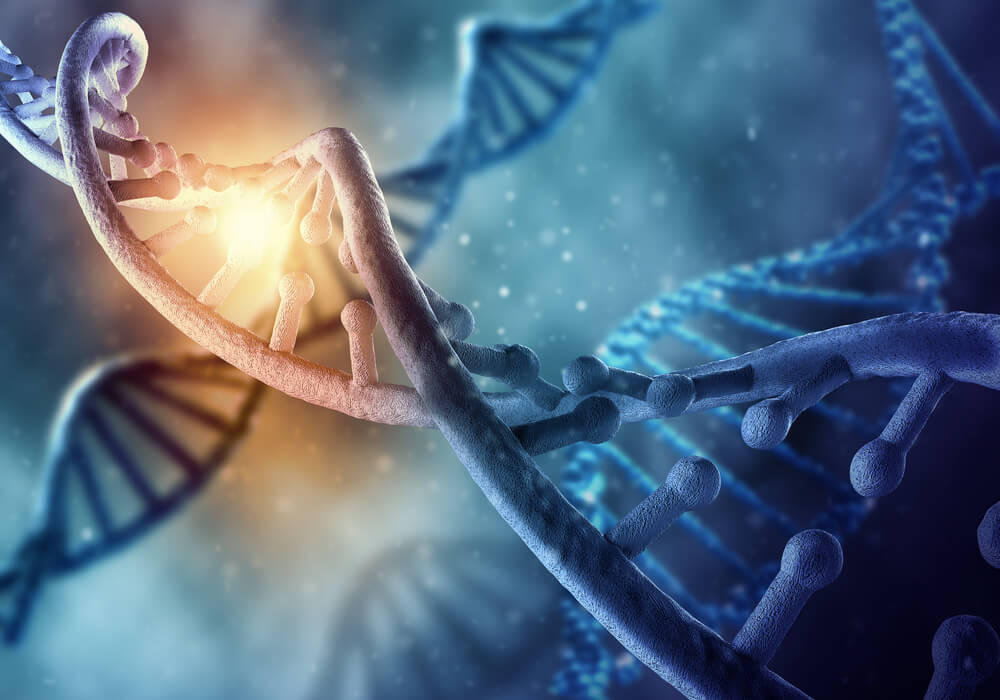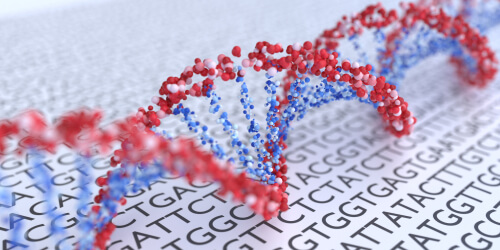All You Need to Know About DNA


Escrito y verificado por Farmacéutica Clara Sebastin
DNA is deoxyribonucleic acid, which contains the information necessary to synthesize proteins. It’s found inside all our cells and all other living beings and is hereditary. Here’s a quick guide with all you need to know about DNA, don’t miss it!
Eukaryotic organisms, including ourselves, have DNA in the cell nucleus. In contrast, prokaryotes, like bacteria, have DNA in the cytoplasm.
All about DNA, a complex molecule
The discovery of DNA
DNA was first isolated in a laboratory by biologist Friedrich Miescher. He discovered that there was a substance in the nucleus of cells, DNA, which he called nuclein.
Subsequently, the biochemist PA Levene discovered that it’s made up of phosphate, the sugar deoxyribose, and four nitrogenous bases. These are:
- Cytosine (C)
- Guanine (G)
- Adenine (A)
- Thymine (T)
In addition, Chargaff showed that, with few exceptions, all DNAs have the same number of thymine and adenine molecules, and as many cytosines as guanine.
In 1953, from the X-ray diffraction data obtained by Rosalind Franklin, Watson and Crick proposed the double helix structure. These revolutionized and marked the beginning of the advancement of molecular biology in subsequent decades.

The double helix structure
Thus, DNA is a right-handed double helix made up of two nucleotide chains. Right-handed means that it turns to the right. Nucleotides are the structural basis of DNA and have three components:
- Deoxyribose sugar
- Nitrogen base: which can be, as we have said, cytosine (C), adenine (A), guanine (G) or thymine (T)
- The phosphate group
The nitrogenous bases of one chain join with those of the other: adenine with thymine (AT) and guanine with cytosine (GC). These pairings are responsible for the characteristic spatial structure of DNA.
In this way, both nucleotide chains are complementary and antiparallel, because they go in the opposite direction from each other.
DNA: the key to life
DNA is the only way to store biological information. What’s more, it’s hereditary and contains the code to create and maintain every organism: the genetic code.
The genetic code establishes the correspondence between nucleotides and amino acids. Furthermore, the order of distribution of the four bases (A, T, C, G) along the chain determines the amino acids that will be synthesized.
The amino acids are then combined to form proteins. The correct folding of proteins is essential for their activity.
Proteins bind to other elements, which will end up constituting a cell. In this way, from the DNA the basic structural unit of living beings is created: the cell.

Mutations and cancer
Mutations are changes or variations in DNA sequences. If they’re produced in somatic cells, they aren’t transmitted to offspring, but they are if they’re produced in germ cells. Some mutations can have beneficial effects, but most are harmful.
Beneficial mutations: evolution
In this case, a mutation modifies a protein. This is, in some way, an adaptive advantage. Individuals with the mutation, thanks to natural selection, survive and pass it on to their offspring. This is the biological basis of evolution.
Harmful mutations
Depending on their consequences, harmful mutations can be of several types:
- Compatible with life: they can be ‘silent’ or mutations that modify a protein, but whose effects aren’t lethal. The latter case is that of diseases such as albinism or sickle cell anemia. The silent ones, despite presenting changes in the DNA, don’t modify any proteins.
- Lethal: these modify proteins that are essential for life, causing death.
- Deleterious: these modify proteins and decrease the chances of survival.
- Carcinogens: these are responsible for the appearance of a tumor.
- Teratogens: these cause malformations in the fetus and in newborns. They may be due to chemicals or radiation on the pregnant woman.

Cancer
The accumulation of carcinogenic mutations causes cells to divide uncontrollably, causing tumors or carcinomas. Thus, for a healthy cell to become cancerous, many mutations must accumulate. In addition, so-called ‘epigenetic changes’ must occur, which are changes in the environment and regulation of cells.
Cancer cells can invade nearby tissues; this process is known as metastasis. They can get into the bloodstream and spread to the rest of the body. Thus, they form a new tumor in another tissue.
DNA is deoxyribonucleic acid, which contains the information necessary to synthesize proteins. It’s found inside all our cells and all other living beings and is hereditary. Here’s a quick guide with all you need to know about DNA, don’t miss it!
Eukaryotic organisms, including ourselves, have DNA in the cell nucleus. In contrast, prokaryotes, like bacteria, have DNA in the cytoplasm.
All about DNA, a complex molecule
The discovery of DNA
DNA was first isolated in a laboratory by biologist Friedrich Miescher. He discovered that there was a substance in the nucleus of cells, DNA, which he called nuclein.
Subsequently, the biochemist PA Levene discovered that it’s made up of phosphate, the sugar deoxyribose, and four nitrogenous bases. These are:
- Cytosine (C)
- Guanine (G)
- Adenine (A)
- Thymine (T)
In addition, Chargaff showed that, with few exceptions, all DNAs have the same number of thymine and adenine molecules, and as many cytosines as guanine.
In 1953, from the X-ray diffraction data obtained by Rosalind Franklin, Watson and Crick proposed the double helix structure. These revolutionized and marked the beginning of the advancement of molecular biology in subsequent decades.

The double helix structure
Thus, DNA is a right-handed double helix made up of two nucleotide chains. Right-handed means that it turns to the right. Nucleotides are the structural basis of DNA and have three components:
- Deoxyribose sugar
- Nitrogen base: which can be, as we have said, cytosine (C), adenine (A), guanine (G) or thymine (T)
- The phosphate group
The nitrogenous bases of one chain join with those of the other: adenine with thymine (AT) and guanine with cytosine (GC). These pairings are responsible for the characteristic spatial structure of DNA.
In this way, both nucleotide chains are complementary and antiparallel, because they go in the opposite direction from each other.
DNA: the key to life
DNA is the only way to store biological information. What’s more, it’s hereditary and contains the code to create and maintain every organism: the genetic code.
The genetic code establishes the correspondence between nucleotides and amino acids. Furthermore, the order of distribution of the four bases (A, T, C, G) along the chain determines the amino acids that will be synthesized.
The amino acids are then combined to form proteins. The correct folding of proteins is essential for their activity.
Proteins bind to other elements, which will end up constituting a cell. In this way, from the DNA the basic structural unit of living beings is created: the cell.

Mutations and cancer
Mutations are changes or variations in DNA sequences. If they’re produced in somatic cells, they aren’t transmitted to offspring, but they are if they’re produced in germ cells. Some mutations can have beneficial effects, but most are harmful.
Beneficial mutations: evolution
In this case, a mutation modifies a protein. This is, in some way, an adaptive advantage. Individuals with the mutation, thanks to natural selection, survive and pass it on to their offspring. This is the biological basis of evolution.
Harmful mutations
Depending on their consequences, harmful mutations can be of several types:
- Compatible with life: they can be ‘silent’ or mutations that modify a protein, but whose effects aren’t lethal. The latter case is that of diseases such as albinism or sickle cell anemia. The silent ones, despite presenting changes in the DNA, don’t modify any proteins.
- Lethal: these modify proteins that are essential for life, causing death.
- Deleterious: these modify proteins and decrease the chances of survival.
- Carcinogens: these are responsible for the appearance of a tumor.
- Teratogens: these cause malformations in the fetus and in newborns. They may be due to chemicals or radiation on the pregnant woman.

Cancer
The accumulation of carcinogenic mutations causes cells to divide uncontrollably, causing tumors or carcinomas. Thus, for a healthy cell to become cancerous, many mutations must accumulate. In addition, so-called ‘epigenetic changes’ must occur, which are changes in the environment and regulation of cells.
Cancer cells can invade nearby tissues; this process is known as metastasis. They can get into the bloodstream and spread to the rest of the body. Thus, they form a new tumor in another tissue.
- Nelson D, Cox M, Lehninger A. Lehninger principios de bioquímica (2018). 7a ed.
- Harvey R, Ferrier D. Bioquímica (2014). 6a ed.
- Genética del cáncer. National Cancer Institute (2019). [sitio web]. Disponible en: https://www.cancer.gov/espanol/cancer/causas-prevencion/genetica
Este texto se ofrece únicamente con propósitos informativos y no reemplaza la consulta con un profesional. Ante dudas, consulta a tu especialista.







